You have an Azure IoT solution that includes a standard tier Azure IoT hub and an IoT device.
The device sends one 100-KB device-to-cloud message every hour.
You need to calculate the total daily message consumption of the device.
What is the total daily message consumption of the device?
B
100 KB * 24 is around 2,400 bytes.
The 100 KB message is divided into 4 KB blocks, and it is billed for 25 messages. 25 times 24 is 600
Note: The maximum message size for messages sent from a device to the cloud is 256 KB. These messages are metered in 4 KB blocks for the paid tiers so for instance if the device sends a 16 KB message via the paid tiers it will be billed as 4 messages.
Reference:
https://azure.microsoft.com/en-us/pricing/details/iot-hub/
You have 1,000 devices that connect to an Azure IoT hub.
You are performing a scheduled check of deployed IoT devices.
You plan to run the following command from the Azure CLI prompt. az iot hub query --hub-name hub1 --query-command "SELECT * FROM devices WHERE connectionState = 'Disconnected'"
What does the command return?
B
Device twin queries: IoT Hub exposes the device twins as a document collection called devices. For example, the following query retrieves the whole set of device twins:
SELECT * FROM devices -
Reference:
https://docs.microsoft.com/en-us/azure/iot-hub/iot-hub-devguide-query-language#device-and-module-twin-queries
You have an Azure IoT solution that includes several Azure IoT hubs.
A new alerting feature was recently added to the IoT devices. The feature uses a new device twin reported property named alertCondition.
You need to send alerts to an Azure Service Bus queue named MessageAlerts. The alerts must include alertCondition and the name of the IoT hub.
Which two actions should you perform? Each correct answer presents part of the solution.
NOTE: Each correct selection is worth one point.
CD
C: Device twins change notifications allow back end applications to be notified in real-time of twin changes and react as business logic requires. For instance, when building an application that notifies an operator directly that a device has a firmware update pending and is ג€ready to updateג€. This is accomplished by creating a routing rule from the ג€Twin Change Eventsג€ source and filtering all events that involve the software update status.
D: Applying enrichments -
The messages can come from any data source supported by IoT Hub message routing, including the following examples:
✑ -->device twin change notifications -- changes in the device twin
✑ device telemetry, such as temperature or pressure
✑ device life-cycle events, such as when the device is created or deleted
Reference:
https://docs.microsoft.com/en-us/azure/iot-hub/iot-hub-message-enrichments-overview https://azure.microsoft.com/en-us/blog/enhancements-to-azure-iot-hub-improve-management-of-the-full-device-lifecycle/
DRAG DROP -
You have 100 devices that connect to an Azure IoT hub.
You need to be notified about failed local logins to a subset of the devices.
Which three actions should you perform in sequence? To answer, move the appropriate actions from the list of actions to the answer area and arrange them in the correct order.
Select and Place: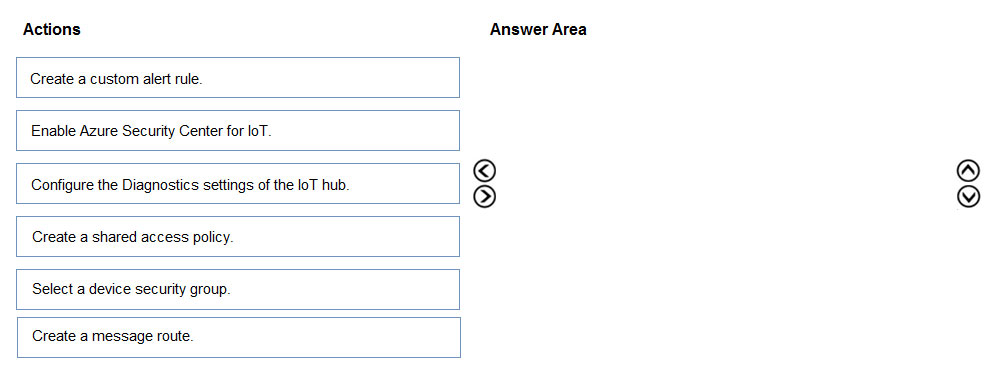
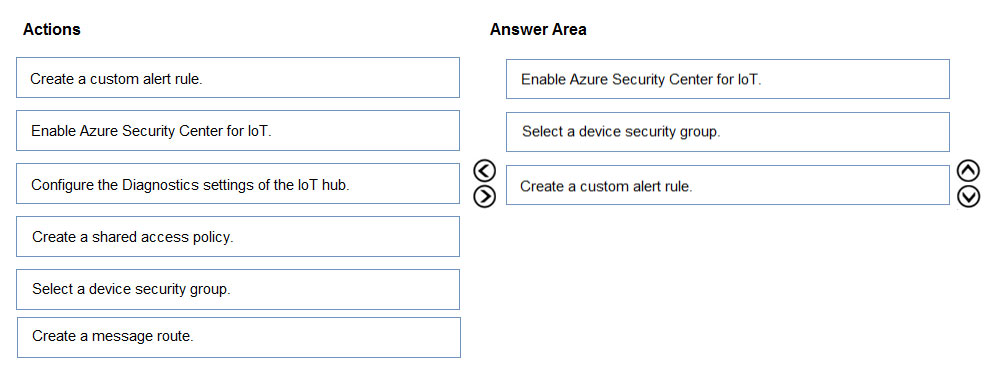
Step 1: Enable Azure Security Center for IoT
Security alerts, such as failed local IoT hub logins, are stored in AzureSecurityOfThings.SecurityAlert table in the Log Analytics workspace configured for the
Azure Security Center for IoT solution.
Step 2: Select a device security group
Update a device security group..
Step 3: Create a custom alert rule
..by creating a custom alert rule
Reference:
https://docs.microsoft.com/bs-latn-ba/azure/asc-for-iot/how-to-security-data-access https://docs.microsoft.com/en-us/rest/api/securitycenter/devicesecuritygroups/createorupdate
You have an Azure IoT solution that includes a basic tier Azure IoT hub named Hub1 and a Raspberry Pi device named Device1. Device1 connects to Hub1.
You back up Device1 and restore the backup to a new Raspberry Pi device.
When you start the new Raspberry Pi device, you receive the following error message in the diagnostic logs of Hub1: "409002 LinkCreationConflict."
You need to ensure that Device1 and the new Raspberry Pi device can run simultaneously without error.
Which two actions should you perform? Each correct answer presents part of the solution.
NOTE: Each correct selection is worth one point.
AE
Note: Symptoms -
You see the error 409002 LinkCreationConflict in logs along with device disconnection or cloud-to-device message failure.
Cause -
Generally, this error happens when IoT Hub detects a client has more than one connection. In fact, when a new connection request arrives for a device with an existing connection, IoT Hub closes the existing connection with this error.
Reference:
https://docs.microsoft.com/en-us/azure/iot-hub/iot-hub-troubleshoot-error-409002-linkcreationconflict#symptoms https://devblogs.microsoft.com/iotdev/understand-different-connection-strings-in-azure-iot-hub/
You have 1,000 devices that connect to an Azure IoT hub.
You discover that some of the devices fail to send data to the IoT hub.
You need to ensure that you can use Azure Monitor to troubleshoot the device connectivity issues.
Which two actions should you perform? Each correct answer presents part of the solution.
NOTE: Each correct selection is worth one point.
BD
The IoT Hub resource logs connections category emits operations and errors having to do with device connections. The following screenshot shows a diagnostic setting to route these logs to a Log Analytics workspace: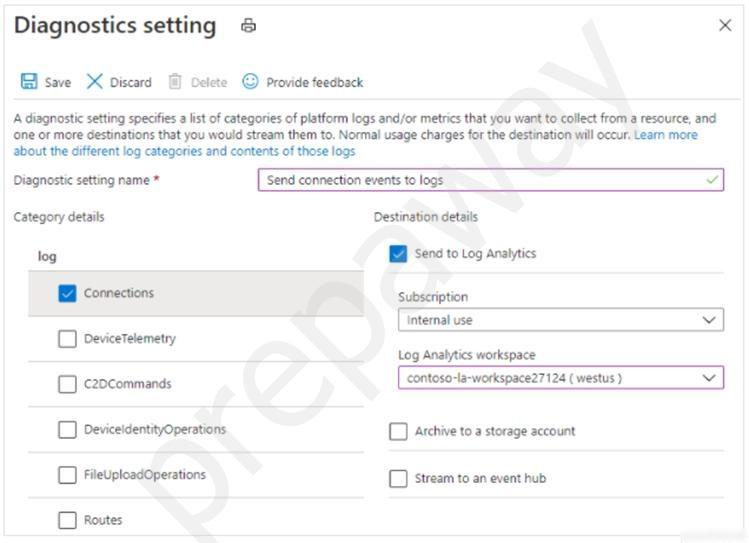
Note: Azure Monitor: Route connection events to logs:
IoT hub continuously emits resource logs for several categories of operations. To collect this log data, though, you need to create a diagnostic setting to route it to a destination where it can be analyzed or archived. One such destination is Azure Monitor Logs via a Log Analytics workspace, where you can analyze the data using Kusto queries.
Reference:
https://docs.microsoft.com/en-us/azure/iot-hub/iot-hub-troubleshoot-connectivity
You have an Azure IoT solution that includes an Azure IoT hub.
You plan to deploy 10,000 IoT devices.
You need to validate the performance of the IoT solution while 10,000 concurrently connected devices stream telemetry. The solution must minimize effort.
What should you deploy?
A
The IoT solution accelerators are complete, ready-to-deploy IoT solutions that implement common IoT scenarios. The scenarios include connected factory and device simulation.
Use the Device Simulation solution accelerator to run simulated devices that generate realistic telemetry. You can use this solution accelerator to test the behavior of the other solution accelerators or to test your own custom IoT solutions.
Reference:
https://docs.microsoft.com/en-us/azure/iot-accelerators/about-iot-accelerators
You have an Azure IoT Central application that monitors 100 IoT devices.
You need to generate alerts when the temperature of a device exceeds 100 degrees. The solution must meet the following requirements:
✑ Minimize costs
✑ Minimize deployment time
What should you do?
D
You can create rules in IoT Central that trigger actions, such as sending an email, in response to telemetry-based conditions, such as device temperature exceeding a threshold.
Reference:
https://docs.microsoft.com/en-us/azure/iot-central/core/howto-configure-rules-advanced
Note: This question is part of a series of questions that present the same scenario. Each question in the series contains a unique solution that might meet the stated goals. Some question sets might have more than one correct solution, while others might not have a correct solution.
After you answer a question in this section, you will NOT be able to return to it. As a result, these questions will not appear in the review screen.
You have 20 IoT devices deployed across two floors of a building. The devices on the first floor must be set to 60 degrees. The devices on the second floor must be set to 80 degrees.
The device twins are configured to use a tag that identifies the floor on which the twins are located.
You create the following automatic configuration for the devices on the first floor.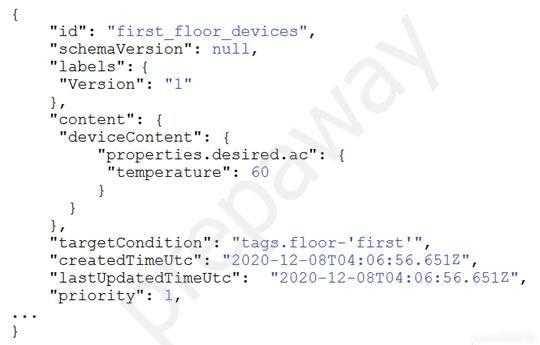
You create the following automatic configuration for the devices on the second floor.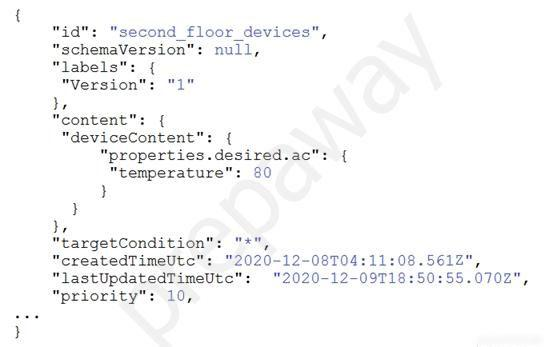
The IoT devices on the first floor report that the temperature is set to 80 degrees.
You need to ensure that the first-floor devices are set to the correct temperature.
Solution: In the automatic configuration for the second-floor devices, you set targetCondition to "tags.floor='second'".
Does this meet the goal?
A
Reference:
https://docs.microsoft.com/en-us/azure/iot-edge/module-deployment-monitoring?view=iotedge-2020-11 https://docs.microsoft.com/en-us/azure/iot-hub/iot-hub-automatic-device-management-cli
Note: This question is part of a series of questions that present the same scenario. Each question in the series contains a unique solution that might meet the stated goals. Some question sets might have more than one correct solution, while others might not have a correct solution.
After you answer a question in this section, you will NOT be able to return to it. As a result, these questions will not appear in the review screen.
You have 20 IoT devices deployed across two floors of a building. The devices on the first floor must be set to 60 degrees. The devices on the second floor must be set to 80 degrees.
The device twins are configured to use a tag that identifies the floor on which the twins are located.
You create the following automatic configuration for the devices on the first floor.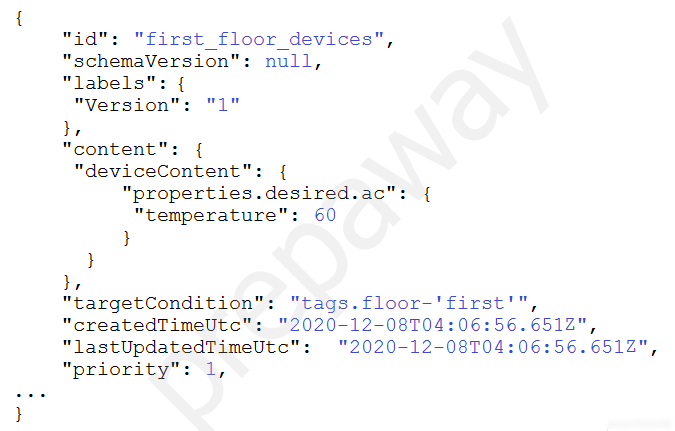
You create the following automatic configuration for the devices on the second floor.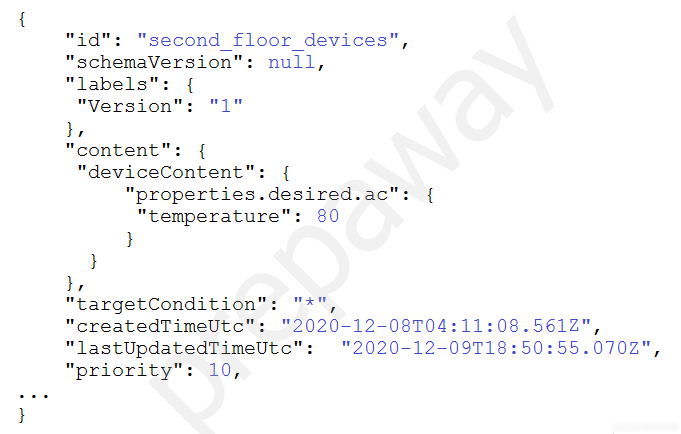
The IoT devices on the first floor report that the temperature is set to 80 degrees.
You need to ensure that the first-floor devices are set to the correct temperature.
Solution: In the automatic configuration for the second-floor devices, you set Version to 2.
Does this meet the goal?
B
Reference:
https://docs.microsoft.com/en-us/azure/iot-edge/module-deployment-monitoring?view=iotedge-2020-11 https://docs.microsoft.com/en-us/azure/iot-hub/iot-hub-automatic-device-management-cli